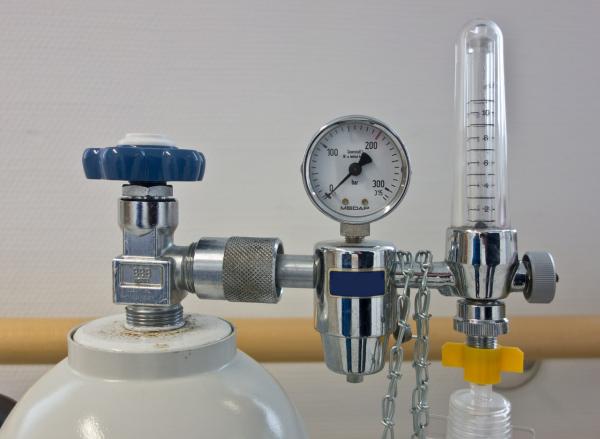When we think about oxygen, we tend to simply think about the air we breathe in on a daily basis. But, the air we breathe isn’t exactly 100% oxygen. The air in the atmosphere only contains about 21% oxygen and 78% nitrogen, with the remaining 1% including a variety of other gases like carbon dioxide and argon. Oxygen is a versatile gas and could be used in many applications.
When thinking about the many ways oxygen is used, the medical industry is one of many industries that use oxygen gas on a daily basis. From saving lives to getting medical procedures underway, oxygen is a gas that helps sustain life.
What Exactly is Medical Oxygen?
Medical oxygen is vital to healthcare providers and is used to support the human and animal respiratory systems in hospitals and clinical settings. Oxygen gas is all created the same way, through fractional distillation of liquid air, but the thing that sets medical oxygen apart from aviation-grade or welding grade oxygen is the way cylinders are filled and the certification requirements for medical grade oxygen.
FDA Requirements for Medical Oxygen
USP grade oxygen cylinders are labeled as USP (United States Pharmacopeia). In order for oxygen to be labeled USP, the cylinder must be certified by the United States Pharmacopeia and filled with a minimum of 99% oxygen.
Medical grade USP oxygen requires a doctor’s prescription and is regulated by the FDA. Since it’s considered a controlled substance, a doctor must issue a prescription indicating flow rate, usually in liters per minute. Ultimately, the amount of oxygen required varies case by case and requires a doctor’s evaluation.
When using oxygen for human respiration, you must use USP grade (Grade A) oxygen vs. industrial or welding grade oxygen. Medical oxygen tanks are required to be cleaned of any chemical impurities or odors. The FDA requires medical oxygen cylinders to be evacuated before filling in order to reduce the risk of contamination vs. industrial or welding oxygen that does not need to be evacuated before re-filling.
Ways Medical Oxygen is Used
- Oxygen Therapy – Oxygen is used for oxygen therapy in hospitals, clinics, and veterinary offices, which provides people with supplemental or extra oxygen. The oxygen is typically administered through an oxygen mask, nasal prongs or a breathing tube. Common conditions, like asthma, pneumonia, pulmonary disease, and tissue restoration require the need for extra oxygen.
- Anesthetics – Oxygen acts as a base or carrier for any anesthetics that are administered to patients.
- Resuscitation – During life-threatening emergencies, medical oxygen is used to help resuscitate a person who isn’t breathing and to keep them stable after regaining their breath.
- Life Support – In cases of medical commas and life support, medical oxygen is used to sustain life for artificially ventilated patients.
Medical oxygen is also commonly used for portable oxygen concentrations for people who can’t get enough oxygen on their own and need oxygen therapy on a daily basis. These are specific for home-usage. Although we are a carrier of medical oxygen, we no longer supply oxygen for home use. We only provide medical gases to certified hospitals, medical clinics, and veterinary offices and are able to deliver straight to your location with scheduled delivery service.
Potential Hazards
Oxygen may not seem like a harmful gas, but when you have too much of something, there could be possible side effects. When administering oxygen to patients, it’s important to monitor patient vitals.
If a person uses too much oxygen there are a few possible side effects that can arise:
- Nasal Irritation – One of the ways oxygen is administered to patients is through tubing that goes through the nasal canal, which can cause irritation if left for too long. To reduce irritation or bleeding, patients can switch over to a face mask instead.
- Hypoxic Respiratory Drive – Those with Chronic Obstructive Pulmonary Disease (COPD) are higher risk for hypoxic respiratory drive, which can potentially make someone stop breathing if they are given too much gas. A way to avoid this from happening is to start the patient off with a lower flow rate.
- Pulmonary Oxygen Toxicity – This most commonly occurs with patients that set a flow rate higher than prescribed. When too much highly concentrated oxygen gas is being breathed in, the lungs’ lining tissue and air sacs can become damaged and can cause fluid leakage into the air sacs resulting in shortness of breath.
Safety Guidelines
Along with other gases, oxygen gas can become very dangerous if not handled properly. High oxygen concentration can make objects burn and in some extreme cases can cause an explosion. Here are some general safety guidelines to follow when handling any type of oxygen gas cylinder:
- Keep the cylinder upright at all times.
- Do not keep the cylinder near any heat source like stoves, ovens, fireplaces, radiators, etc.
- Do not let anyone spark a flame in a room where oxygen is in use.
- Make sure to only use oxygen gas as prescribed by your doctor.
- Always keep cylinders in a well-ventilated area in case of leakage.
Longmont Oxygen Supplier
Having medical oxygen on hand at all times is very important in the medical field. You want to make sure your clinic is always stocked with oxygen and that’s why healthcare clinics and hospitals rely on Wagner Welding as their supplier of choice. We make sure your delivery is always on schedule and on time.
Our highly experienced staff is happy to work with you to choose the best oxygen solution for your needs. If you’re looking to order regular gas delivery to your medical hospital or clinic, please call us to get a quote and schedule a local delivery!
Sources:
https://www.oxygenconcentratorstore.com/blog/what-is-medical-grade-oxygen-and-why-do-i-need-an-rx/
http://www-personal.umich.edu/~lpt/oxlabel.htm
https://www.bochealthcare.co.uk/en/products-and-services/products-and-services-by-category/medical-gases/medical-oxygen/medical-oxygen.html
https://intermountainhealthcare.org/ckr-ext/Dcmnt?ncid=521117400https://healthfully.com/what-are-the-side-effects-of-oxygen-therapy-4819440.html
https://healthfully.com/what-are-the-side-effects-of-oxygen-therapy-4819440.html

